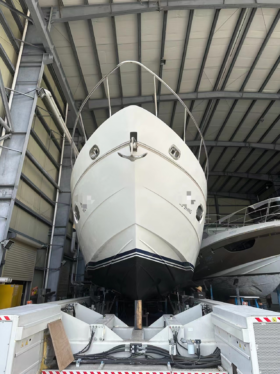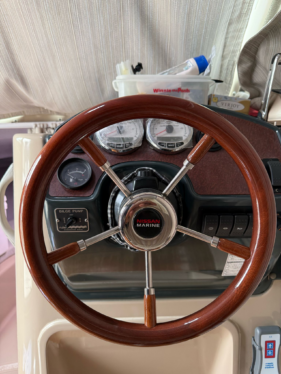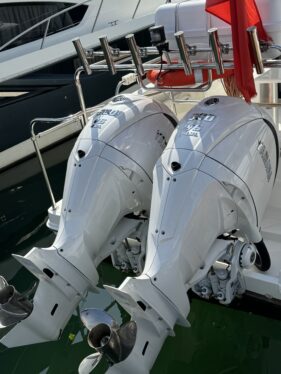Studies have shown that the maintenance rules for yachts and speedboats vary from type to type and require regular inspections to ensure safety and performance.
- Yacht maintenance includes cleaning, engine maintenance, hull inspections, electrical systems and piping systems, etc., with special attention to the effects of the saltwater environment.
- Speedboat maintenance focuses on the engine and drive system, involving oil changes, flushing and anti-corrosion measures, and Yamaha jet boats have specific steps.
This article will take you through the details of the precautions for boat maintenance.
Yacht maintenance
Yachts are large recreational vessels and maintenance requires comprehensive coverage of multiple systems. Here are the main steps:
1. General maintenance
Cleaning: Wash the hull regularly to remove dirt, corrosion, and invasive species. Especially in saltwater environments, cleaning is essential to prevent corrosion. It is recommended to wash the exterior every two weeks at a cost of about $2-$3 per foot.
- Oil Change: Check and change the oil regularly to ensure engine performance. It is generally recommended to replace it every 50 hours or according to the manufacturer’s recommendation and to record it in the maintenance log.
- Air Filter: Replace the air filter regularly to ensure the engine is getting enough clean air to prevent a drop in efficiency.
- Battery charging: Make sure the battery is in good condition, especially during extended downtime. Consider installing an Onboard Charger for ease of management and recommend replacing the battery every 4-5 years.
- Instrument inspection: Regularly check the speed, fuel and other gauges to ensure their accuracy and avoid misjudgment during the voyage.
- Engine Inspection: After each use, inspect and rinse the engine, especially after using salt water. Flushing can prevent salt build-up that can lead to corrosion, and fresh water flushing is recommended.
- Propeller inspection: Regularly check the propeller for damage or deformation, and repair or replace it in time, paying special attention to impact damage.
- Electrical System: Inspect the electrical system, including wiring, switches, and connections, annually or quarterly, to ensure there are no corrosion or loosening issues. Use a multimeter to make sure the voltage drop is less than 3%.
- Hull Inspection: Regularly inspect the hull for cracks, dents, or water leaks. Pay special attention to gelcoat cracks, minor cracks may be harmless, but transverse cracks may indicate structural problems.
- Hose Inspection: Check the hose for wear, tear or cracks, and replace the damaged parts in time to prevent water leakage.
- Fuel reserves: Keep extra fuel in case of emergencies, it is recommended not to fill up the gas tank and leave 10% of the space to prevent leakage.
- Water tanks and pipes: Monitor the condition of fresh water tanks and pipes to ensure there are no leaks or contamination issues. Fresh water tanks are located in the deepest part and are used for drinking, sinks, showers through pumps.
- Seats: Especially in saltwater environments, regularly inspect the seats for wear or discoloration and dispose of them promptly. Use a seat cover to extend life and prevent the growth of pink bacteria (streptoverticillium reticulum).
- Annual overhaul: Annual overhaul is carried out, including repainting, lubrication, etc., to extend the life of the hull. It is advisable to tow the boat out of the water every two or three years and reprime.
- Safety checks: Regularly inspect life jackets, first aid kits, fire extinguishers, flare guns, and running lights to ensure their effectiveness. The U.S. Coast Guard provides free security checks, which are recommended to be conducted annually.

2. Engine maintenance
- Oil Change: Change the oil regularly, and check the belt and hose. After using salt water, the engine must be flushed to prevent corrosion. It is recommended to replace it every 50 hours and check for burnt or contamination.
- Diesel engine life: Diesel engines have a life of about 5,000 hours, but they can be extended with proper maintenance. It is advisable to send oil samples to the laboratory for testing on a regular basis to detect potential problems.
- Troubleshooting: If the engine is splashing at full speed, check the spark plugs, gasoline, and oil for corrosion or dirt. Use a multimeter to check the electrical connections to make sure there are no short circuits.
- Fuel Safety: Never fill up your gas tank completely, leaving 10% of the space to prevent spills, fire, or explosions. Prevent oxidation with marine-specific fuel stabilizers.

3. Hull maintenance
- Gelcoat Cracks: Check the hull for Gelcoat cracks. Minor cracks may be harmless, but transverse cracks may indicate structural problems and need to be professionally repaired if cracks can be inserted into the fingers.
- Hull bending: Inspect the hull for bends or vibrations, which may indicate structural damage. Particular attention is paid to the deformation or lamination separation of fiberglass boats in turbulence.
- Soft spot inspection: Look for soft spots, which can be caused by water damage, rotten wood, or peeling fiberglass. Steel hulls are the most durable, but be aware of rust.
- Impact Damage: The most common damage is impact damage (hitting another boat, bottoming out, or hitting a dock) that needs to be repaired promptly and is recommended to be towed out of the water for inspection every two years.
4. Electrical system
- Diagnostic Tools: Use a multimeter to diagnose problems. Make sure the AC is turned off and consult a professional if you are not familiar with it. Check if the voltage drop is greater than 3%, if so, it may be that the wire specification is incorrect.
- Common Issues: Dead batteries, old cables, corrosion, loose connections are common problems. After a long period of inactivity, the battery is most likely to fail, so it is recommended to bring a charger.
- Poor grounding: Use a multimeter to check if there is a bad grounding (DC setting, battery on, check for leakage). If a problem is found, replace the damaged part immediately.
5. Piping system
- Fresh water tank: Check the fresh water tank (deepest) for drinking, sink, shower through the pump. Make sure there are no water leaks or contamination and clean regularly.
- Toilet system: chemical or sea sluice with mesh filter. The black water tank needs to be evacuated (flushed directly at a distance of 3 nautical miles), the grey water is filtered back, and biodegradable soap is used to protect marine life.
- Water ingress treatment: wear a life jacket, stop the boat, find and plug the hole, drain the water. If sinking, call the coast guard, it is advisable to carry an emergency pump.
6. Ship interiors
Discoloration problems: Check for discoloration (sunlight, heat, salt water, dehydrochlorination). It is recommended to use a UV shield to protect the seat and prolong its life.
- Pink bacteria: Pink bacteria (streptoverticillium reticulum) are risk-free but grow between foam and vinyl and are caused by fresh water, warmth, food, and oxygen. Regular cleaning can prevent.
- Refurbishment: Refurbishment is cheaper than buying a new one, the cost is about 30-50% of the new seat, and it is recommended to use a protective cover to extend the life.

7. Special attention should be paid in the saltwater environment
- Cleaning & Flushing: Wash the boat after use, wipe down the metal parts, rinse the engine with fresh water, and relubricate the metal parts with fresh water. Salt water can cause modules to erode up to 10 times faster than freshwater.
- Hull paint: Use hull paint suitable for salt water to prevent shellfish from attaching. It is recommended to reprime every two years.
- Plug-in engine: Lift the plug-in engine to avoid growth and corrosion of marine organisms, check the anode regularly, and replace it when it is 50% lost.
- Fiberglass boat: Do not leave it in salt water for more than a few weeks, it will grow shellfish and affect performance.

Speedboat maintenance
Speed boats are known for their high-speed performance and include running boats, sports boats, racing boats and personal jet skis. Below are the detailed maintenance steps for a speedboat, divided into general maintenance and maintenance guidelines for specific models such as Yamaha jet boats.
1. General maintenance (applicable to all speedboats)
A. Engines and Drives
- For each departure:
- Check and replenish the oil to make sure the levels are normal.
- Check the outboard fixing bolts/lifter bolts to make sure there are no loosening.
- Inspect the propeller and keel for damage, paying special attention to impact marks.
- Check the hood air intake for blockages to make sure it is well ventilated.
- Check the engine operating temperature to make sure it is within the normal range.
- Check the oil pressure, and stop the machine immediately for inspection if it is abnormal.
- Every 50 hours:
- Check the drive/gearbox for water/particles/scorched lubricant and replenish with new lubricant.
- Check whether the engine is running RPM properly under WOT (Full On) to ensure performance.
- Inspect fuel lines for alcohol and UV degradation and replace them if necessary.
- Replace the fuel/water separation filter to prevent impurities from entering the engine.
- Check and, if necessary, replenish the power lift/tilt fluid to ensure that the hydraulic system is in good working order.
- Check the engine mounts and turn/steer brackets for excessive clearance and adjust them to prevent loosening.
- Every 100 hours:
- Lubricate all lubrication points, using an appropriate lubricant such as silicone spray.
- Apply silicone protective spray to all accessible bolts/fasteners to prevent corrosion.
- Check the linkage/synchronization to ensure that the engine and drivetrain are in harmony.
- Re-tighten all accessible bolts/fasteners to prevent loosening.
- Touch the paint to repair any peeling or damage.
- Inspect and, if necessary, replace the spark plugs, which should be light brown with sharp edges.
- Change and check the condition of the gearbox lubricant and engine oil to ensure that there are no contaminations.
- Replace the water pump impeller to ensure that the cooling system is normal.
B. Steering system
- For each departure:
- Check for excessive clearance/movement to ensure the steering is sensitive.
- Every 50 hours:
- Check the liquid level/check the leakage/bleed system (hydraulic) to ensure that there is no leakage.
- Check the engine free clearance and adjust it to prevent steering jamming.
- Lubricate all lubrication points to ensure smooth steering.
C. Vessels: interior, roof, safety equipment, hull, hardware
- For each departure:
- inspect the hull for damage; Repair if necessary, paying special attention to impact marks.
- Every 20 hours:
- Clean the hull and deck and use clean water to remove salt and prevent corrosion.

2.Yamaha jet boat specific maintenance
Yamaha jet boats are a common type of speedboat that is known for its high performance.
A. Engine oil change
- With Yamalube® 4W 10W-40 oil (four-stroke boats), check the oil level when the engine reaches full operating temperature, making sure it’s between the scales of the measuring rods. Replace every 50 hours before long-term storage to ensure engine health.
- B. Rinse
- Rinse the engine with clean fresh water after use to prevent corrosion, especially in salt water. Method: Connect the garden hose adapter and run the engine at a fast idle speed for 3-5 minutes, ensuring that water flows out of the jet propulsion nozzle and cooling water diversion outlet.
- C. Corrosion protection
- Rinse the boat with clean water after use, especially in salt water. Hard-to-reach areas are treated with the Yamashield™ engine, and easy-to-reach areas are treated with silicone spray on a monthly basis, product details can be found here and here.
- Clean the anode (replace when 50% is lost) and check the electrical connections with Yamalube® battery terminal cleaner and repellent.
- D. Fuel system maintenance
- Add the Yamalube® Fuel Med RX and Engine Med RX to each tank, product details can be found here and here.
- Inspect hoses and connections for leaks or cracks before each voyage.
- Use Yamaha Internal Engine Cleaner to remove carbon build-up (dealerships only).
- E. Electrical system
- Check the lines and connections for corrosion, and measure the impedance using an ohmmeter (0.1-0.2 ohms max).
- Clean the battery terminals with Yamalube® silicone repellent and lubricant, make sure the connections are clean and tight, use hex nuts and lock washers.
- F. Spark plugs
- Check every 100 hours or every two seasons, replace with the exact manufacturer and model, should be light brown with sharp edges.
- G. Hot and spring valves
- Check for signs of jamming due to sediment and refer to the replacement recommendations in the instruction manual if cleaning is necessary.
- H. Long-term storage
- Replace the engine oil and filter with Yamalube® EFI Fogging Oil or Stor-Rite Engine Fogging Oil spray engine before long-term storage, product details can be found here and here.
- Add the Yamalube Fuel Stabilizer & Conditioner PLUS, store the tank to 7/8 full, dry and clean the boat, use the Yamaha storage hood.
- Charge the battery monthly during storage and load test before storage.

brief summary
Yachts and speedboats, although both recreational vessels, have different maintenance needs. Yachts require more comprehensive system maintenance, including engine, hull, electrical and piping systems, while speedboats focus more on engine performance and quick response. Regular maintenance not only prolongs the life of the boat, but also ensures safe and enjoyable sailing. Boat owners are advised to follow the detailed steps provided in this article to develop an individualized maintenance plan and consult with a professional technician regularly to ensure that everything is working properly.
If you have any boat maintenance needs, or questions about boat maintenance, we are happy to help you:
Wechat:+86 18028120587
Whatsapp Contact: https://wa.link/9ut5br
WhatsApp:+85244249752
Voy/Boatmarket Official Phone: 59048455
📧 Email – enquiry@boatmarket.com.hk
Cite:
- Yatco: Essential Boat Maintenance Guide 2025
- BoatUS: Boat and Trailer Maintenance Checklist
- Yamaha Boats: Maintenance Matters
- Shop Yamaha: 10W-40 Mineral 4W Watercraft Engine Oil
- Shop Yamaha: Yamashield
- Shop Yamaha: Silicone Spray Protectant Lubricant
- Shop Yamaha: Fuel Med RX
- Shop Yamaha: Yamaha Internal Engine Cleaner
- Shop Yamaha: Stor-Rite Engine Fogging Oil
- Shop Yamaha: Yamalube Products Quality Care

